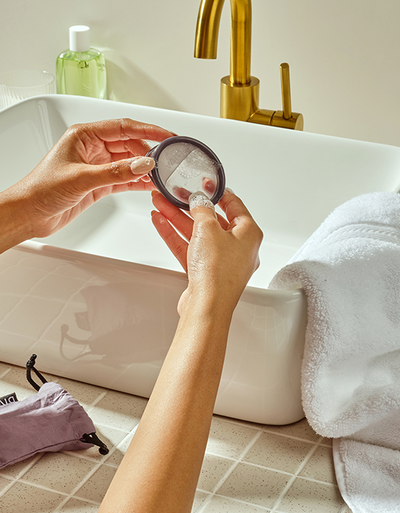

Selon Planned Parenthood , les dispositifs intra-utérins (DIU) sont l'une des meilleures méthodes de contraception – efficaces à plus de 99 %. Un DIU est un petit dispositif en forme de T inséré dans l’utérus pour éviter une grossesse. Ils sont à long terme, réversibles et constituent l’une des méthodes contraceptives les plus efficaces disponibles. Il existe deux types de DIU : le DIU hormonal et un DIU non hormonal au cuivre.

Même si je pense que le DIU peut être un excellent moyen de contraception, le processus d'insertion peut être incroyablement douloureux. Et pour aggraver les choses, les patients ne sont pas avertis de la douleur potentielle, ne se voient pas proposer de gestion de la douleur, et la douleur que nous ressentons est ignorée par professionnels de la santé .
J'ai eu deux DIU insérés dans ma vie. La première a été une expérience vraiment horrible. J'ai appris après avoir vécu cette expérience que je n'étais pas le seul à ressentir une douleur importante.
On m'a dit avant l'intervention que les effets secondaires pourraient ressembler à des crampes menstruelles ou à un pincement inconfortable. Ce que j'ai ressenti à la place, c'est une douleur si intense que je suis parti en larmes, devant prendre un jour et demi de congé le lendemain. À ce jour, je suis sûr que c’est la chose la plus douloureuse que j’ai vécue dans ma vie. C'était tellement grave que j'ai fini par devoir transférer mes soins dans un autre hôpital. J'étais trop traumatisé pour y retourner.
Lorsque j’ai changé de prestataire de soins, j’étais déterminé à me défendre et à veiller à ne plus jamais vivre une telle expérience.
Comment se préparer à l'insertion du DIU
Faites vos propres recherches
Faites vos propres recherches. Découvrez les options disponibles pour soulager la douleur et quelle est la meilleure façon de vous préparer à la procédure d'insertion du DIU. Les options incluent :
- avoir le col gelé,
- prendre des médicaments pour aider à détendre votre col de l'utérus,
- avoir des analgésiques comme le naproxène prescrits à l'avance,
- et se faire prescrire des médicaments calmants pour vous aider à détendre vos nerfs
Si vous avez des problèmes de santé complexes liés à l’utérus, la sédation est également une option. Pour préparer mon deuxième placement de DIU, j'ai fait geler mon col et il a changé tout pour moi.
Discutez de vos problèmes de douleur avec votre médecin
Prenez rendez-vous avant l'insertion pour discuter de vos problèmes de douleur avec votre médecin.
Écrivez des notes pour vous-même afin de savoir exactement de quoi vous voulez discuter et de savoir ce que vous attendez de cette réunion.
Si vous savez que vous avez une faible tolérance à la douleur, vous pouvez indiquer cela comme la raison de votre inquiétude ou simplement référencer certains des articles liés au bas de cet article de blog.
Prenez votre temps
Lorsque vous vous présentez au rendez-vous, laissez votre pantalon pour avoir la possibilité de parler avec votre médecin avant le début du processus.
Lorsque vous vous présenterez au cabinet du médecin, une infirmière vous amènera et vous remettra un drap. Ils vous demanderont de vous déshabiller pendant que vous attendez. Je trouve que cela rend beaucoup plus difficile la défense de vos intérêts, car vous avez déjà commencé le processus – vous avez déjà retiré vos vêtements. Gardez vos vêtements. Lorsque le médecin arrive, demandez-lui de décrire le processus. Ensuite, le médecin peut sortir un instant pour que vous vous changez.
Si cela vous rend nerveux, changez d’abord. Mais restez assis sur le côté du banc et ne bougez pas votre les pieds dans les étriers jusqu'à ce que vous ayez posé toutes vos questions.
Insérez vous-même le spéculum
Demandez à insérer vous-même le spéculum. J'ai appris cela grâce au Sage-femme féministe . Cela a changé la donne pour tous les examens pelviens que j'ai passés depuis. J'insère toujours le spéculum moi-même et je trouve que c'est nettement moins douloureux.
Faites-vous confiance
Enfin, faites-vous confiance ! Vous savez ce dont vous avez besoin plus que quiconque.
Planifiez à l’avance, prenez des notes et sachez que même si cela vous semble gênant, défendre vos intérêts est très important et peut vraiment améliorer votre expérience.
La meilleure forme de contrôle des naissances pour vous
La meilleure forme de contraception pour vous est la meilleure forme de contraception pour toi . Être cela la pilule contraceptive, l'anneau, le timbre, les préservatifs ou le DIU .
Recherchez vos options, déterminez quelle méthode vous convient le mieux et utilisez ces conseils utiles pour vous défendre plus confortablement.












